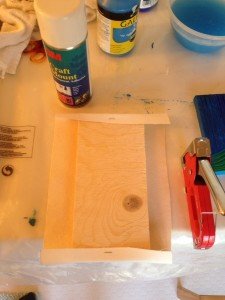So for my latest collection of fluid acrylic paintings I wanted to work on canvas board for a couple of reasons – the main one being that I wanted to put a coat of resin on top and I knew that for that I would need a really flat surface so that the resin would not pool in the middle of the painting.
Although it is definitely possible to put resin onto a canvas I thought I would try it out with a flat canvas on board surface so I decided to set out to make my own canvas board.
I searched around on the internet for a bit to find how people were applying the canvas to the board and a lot of what I found was people using a medium to apply the canvas. I thought I would try something a bit different as it struck me that it would be a good idea to use actual glue to stick the canvas to the board and I had a few options lying around in my studio.
So I tried using a spray glue. I had been using this for applying my certificates of authenticity to the backs of my canvases. the good thing about it is that it gives you a really smooth finish with no lumps or brush marks so you can’t see where it has been applied.
 The spray glue I have is a good quality one, (available in the UK here
The spray glue I have is a good quality one, (available in the UK here, and in the US here) therefore it sticks really well so I was confident that it would give a good result. So the first thing I did was to cut out a piece of board to the size I wanted. Well actually that is not quite true, I got the DIY store to cut me a number of pieces of board from one big piece (and they do this for free) – getting them to do it meant I got a really straight and clean cut on the board. I used 6mm MDF although I have also used plywood that I had left over from a project so either is fine. 6mm I found was thick enough to be quite flat and strong yet thin enough to not be too heavy to hang when finished.
I then cut out my canvas to about an inch wider than the board all round. I sprayed both the board and the canvas and left them for the glue to become tacky for a few minutes. It’s really important to get the glue right to the edges otherwise you might end up with bubbles at the edges of the board. Stick the board down on to the canvas and press down well. With the spray glue it doesn’t take long for the canvas to stick to the board and in fact pretty much immediately you will find it hard to reposition if you need to so make sure you get it in the right place!
The picture on the left shows the smallest one I made but the biggest at the moment is 80 x 80cm.
One the canvas has been stuck to the board and you have ensured that it has all been smoothed down on the front, use a staple gun to the back of the board to fix the canvas (just like if you are stretching a canvas). You should try and get the canvas stretched as tightly as possible – this isn’t too hard once the canvas is glued on.
You can use the canvas board pretty much immediately as you don’t need to wait for the glue to dry out so this is a really good method if you want to paint straight away.